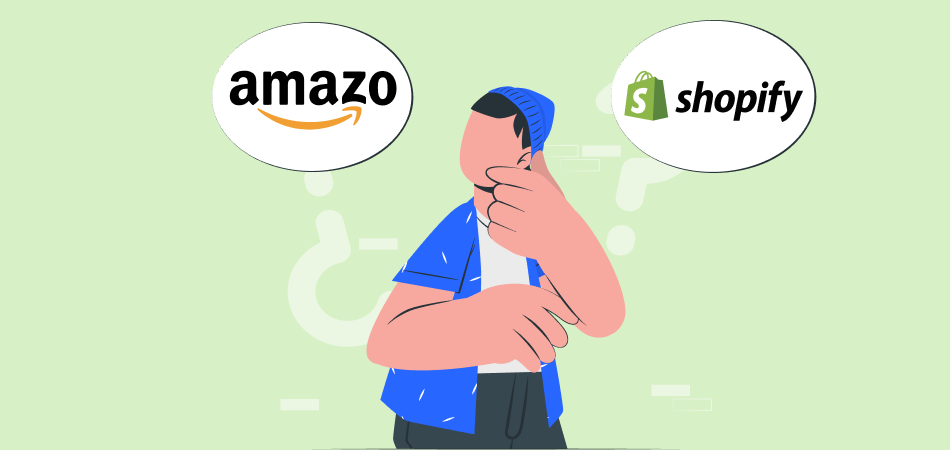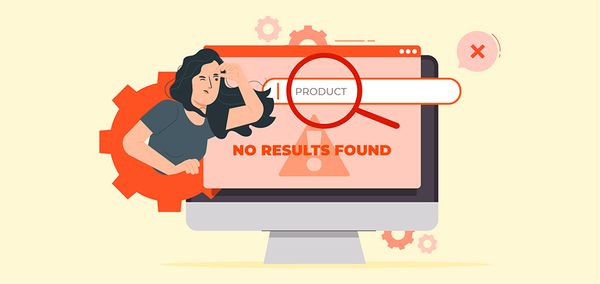Amazon vs. Shopify: Which E-commerce Platform Is Right for Your Business

Choosing between Shopify and Amazon for your online business can take time and effort. We've been writing about this for over a decade, and one of the biggest questions we get is, "Should I use Shopify or Amazon?" According to our research and experience, we lean towards Shopify. Why? Well, Shopify tops our list of e-commerce website builders. It has amazing sales features and everything you need to create your online store. But we get it: Amazon is tempting, too. It's the biggest online marketplace; not building your store can save time. Plus, you get access to a massive audience right off the bat. Ultimately, it boils down to whether you prefer a hands-on or hands-off approach to selling. Both have merits, so let's explore this Amazon vs Shopify guide more thoroughly!
Amazon vs. Shopify: Overview
Amazon is a giant online marketplace where you can buy almost anything, from books to electronics to clothes. It's not just a store—it's also a platform where other people can sell their stuff. Think of it as a huge digital mall where millions of people shop daily.
On the other hand, Shopify is a website platform that helps people build online stores. It's like setting up a lemonade stand on the internet, but instead of just selling lemonade, you can sell all sorts of things. Shopify makes it easy for regular folks to start their businesses online without knowing much about technology or coding.
Amazon vs. Shopify: Mobile-Friendly
Amazon lets users conveniently shop on their smartphones or tablets. The app is designed to be easy to use on smaller screens, and features like one-click purchasing and personalized recommendations enhance the shopping experience.
Shopify also offers mobile-friendly features for both store owners and customers. Store owners can manage their stores, fulfill orders, and track sales using the Shopify app, while customers can easily browse and buy products from Shopify stores on their mobile devices.
When comparing the mobile-friendly features of Amazon and Shopify, both platforms offer convenient mobile apps for users. However, Amazon's app is more focused on providing access to its vast marketplace, while Shopify's app is tailored to help store owners manage their businesses effectively on the go.
Amazon vs. Shopify: Ease of Use
Regarding online selling, Amazon FBA offers a hassle-free setup, handling order fulfillment and customer service. Simply create an Amazon account, list your items, and let FBA take care of the rest. It's a straightforward process designed for ease and efficiency.
On the flip side, setting up a Shopify store may require more time and effort, especially if you want to explore advanced options for customization and customer experience. While Shopify offers default options for quick setup, delving into its full potential demands investment in time and attention.
Ultimately, the choice between Amazon FBA and Shopify depends on your priorities. If you seek a quick and straightforward selling process, Amazon FBA is the way to go. However, if you prioritize customization and advanced features to enhance your online store, Shopify offers greater flexibility and potential for growth.
Amazon vs. Shopify: Pricing
Now, let’s look at the next point - pricing plan for both platforms.
Amazon offers two selling plans: the Professional Selling plan at $39.99 per month plus extra fees and the Individual Selling plan with no monthly fee but a charge of $0.99 per item sold. The Individual plan suits those selling fewer than 40 items monthly but has fewer features, like no customizable shipping rates. Additional costs with Amazon include Fulfillment by Amazon (FBA) fees and referral rates, which can be as high as 45%.
On the other hand, Shopify offers three main plans: Basic at $29 per month, Shopify at $79, and Advanced at $299. Although Shopify may seem pricey, its value for money has improved, with a 3-day free trial and first month at $1. Plus, its yearly plans are up to 25% cheaper than monthly payments. A Starter Plan for Social Media sells at $5 per month. Extra costs with Shopify come from third-party apps, which can boost your business but may require additional investment.
Amazon vs. Shopify: Dropshipping
Both Amazon and Shopify offer opportunities for dropshipping businesses, but they have different advantages and drawbacks. Amazon provides access to a vast customer base but comes with strict rules and competition. Shopify offers more control and flexibility but requires building and marketing your store.

|
Manage Multiple Stores In One Account Multiple Stores Management - Link and manage multiple stores on different platforms in one place |
Amazon allows dropshipping, but it has strict rules and regulations that sellers must follow. Dropshipping on Amazon means listing products from suppliers on the Amazon marketplace and then fulfilling orders as they come in. However, Amazon has specific guidelines for dropshipping, and failure to comply can result in account suspension or closure. Here’s an example of how you can adhere to Amazon’s guidelines for dropshipping:
- Be the Exclusive Seller: Ensure you are the exclusive seller of your list of products. This means you should not share the same product listings with other sellers.
- Include Your Business Name: Make sure your business name appears on invoices, packing slips, and other item details. This helps maintain transparency and avoids confusion for customers.
- Remove Third-Party Seller Information: Before shipping products to customers, remove any information related to third-party sellers. This prevents confusion and ensures a seamless buying experience.
- Handle Returns Responsibly: Take responsibility for handling returns. If a customer wants to return an item, manage the process promptly and professionally.
Shopify also supports dropshipping, and many people use Shopify as a platform to run their dropshipping businesses. With Shopify, you can set up your online store and easily import products from suppliers to sell to your customers. Shopify provides tools to manage your store, process orders, and track inventory, making it a popular choice for dropshipping businesses.
Amazon vs. Shopify: Payment
When it comes to payments comparison between Amazon and Shopify, it's crucial to consider more than just the initial costs. Pay attention to transaction fees and credit card rates, as they can add up and significantly affect your monthly expenses.
Amazon supports Amazon Pay for payments, allowing you to accept credit and debit cards but not PayPal. However, Amazon charges various fees for sellers, including referral and shipping fees, ranging from 8% to 15% of the total sale, with some categories charging as high as 45%. If you opt for FBA (Fulfillment by Amazon), you'll encounter fulfillment and inventory storage fees that vary based on factors like product type and volume.
On the other hand, Shopify offers a more straightforward fee structure. Individual sellers on Shopify don't pay a monthly subscription but instead incur a $0.99 fee per product sold. With Shopify Payments, the platform's native payment gateway, you avoid transaction fees, but credit card fees still apply, starting at 2.9% + 30¢ and decreasing with higher-priced plans. Shopify also supports over 100 other payment gateways, including Amazon Pay and PayPal, each with transaction fees ranging from 0.5% to 2%, depending on the gateway and plan selected. It's essential to assess these factors carefully to determine which platform aligns best with your business needs and budget.
Amazon vs. Shopify: Tools
Amazon and Shopify offer powerful tools for building online stores, combining functionality and aesthetic appeal.
Shopify stands out for its comprehensive sales features, including abandoned cart recovery, AI-driven product description generation, automatic tax calculation, and multichannel selling capabilities, which streamline various aspects of the sales process and alleviate the burden of financial compliance through resources like the Shopify 1099 form. Additionally, its extensive app store provides thousands of customizable tools such as image optimization, live chat, and user-generated content videos, enabling merchants to tailor their stores to specific preferences. DSers, in particular, emerge as a standout tool for simplifying dropshipping operations and enhancing order fulfillment efficiency within the Shopify ecosystem.
On the other hand, Amazon provides a comprehensive array of features tailored to meet the diverse needs of sellers. However, customization options are somewhat limited, with sellers constrained to utilize the same toolkit available to others on the platform. This lack of differentiation can challenge merchants aiming to discover a distinct identity and establish a unique selling proposition in a crowded marketplace.
Shopify vs. Amazon: Advantages and Drawbacks
Shopify and Amazon offer contrasting platforms for online sellers to reach their target audience. Shopify allows sellers to create personalized online stores, granting full control over branding and customer experience. Conversely, Amazon is a bustling marketplace where sellers can list their products alongside numerous competitors. Sellers benefit from the platform's built-in traffic but face challenges in standing out amidst the crowd and maintaining brand identity.
While Amazon offers immediate access to a vast pool of potential customers, sellers contend with intense competition and limited control over branding. In contrast, Shopify empowers sellers to craft unique online storefronts but requires proactive marketing efforts to drive traffic and build a loyal customer base. Despite their differences, both platforms offer distinct advantages and drawbacks, catering to different types of online sellers based on their priorities and business goals.
Conclusion
Amazon vs. Shopify are great online selling platforms but have some key differences. Shopify gives you more control and helps you build a stronger brand identity, making it ideal for starting or growing your online store. Plus, its pricing scales with your business, so you won't face surprise fees as you grow. On the other hand, Amazon is better suited for small sellers who want to avoid upfront costs. However, its additional fees can add up quickly, making it harder to predict your expenses. In the end, Shopify is the better long-term solution, and you can even integrate Amazon into your Shopify store for added benefits. It's a win-win situation!












 Company
Company
 Why Choose DSers
Why Choose DSers
 Blog
Blog
 Help Center
Help Center




 Live Chat
Live Chat